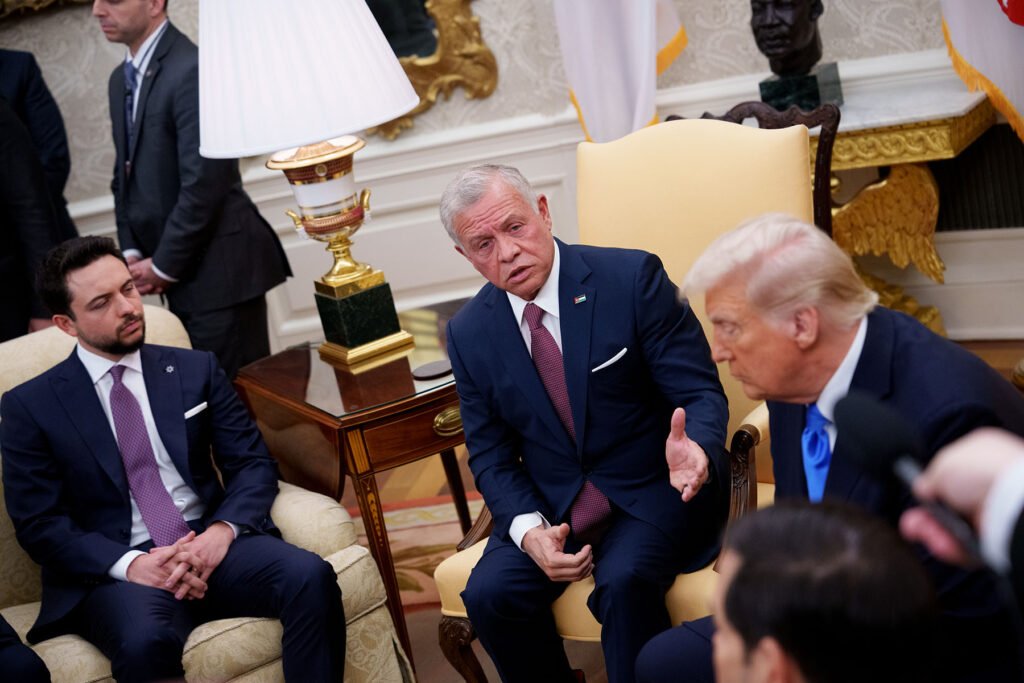Jordan’s leadership and public stood united in denouncing Israel’s war of collective punishment in Gaza after the Hamas-led attack into southern Israel on October 7, 2023. Yet encaged by its geopolitical commitments to heed the American line under President Joe Biden, who had few qualms underwriting Israel’s war machine, the Hashemite regime found itself trapped. Under American pressure, it could not end the peace treaty with Israel, as its citizens demanded. Its pleas to Washington to moderate Israel’s assaults fell on deaf ears. Instead, nervous about domestic instability, Jordanian authorities cracked down on anti-Israel demonstrators and activists. Jordanians interpreted this as their government effectively policing the kingdom on behalf of the Washington-Jerusalem axis, which needed Jordan to remain what it has always been: a compliant authoritarian partner buffering Israel’s eastern flank. That Jordanian forces twice helped shoot down Iranian drones and missiles targeting Israel last year bolstered this feeling. Not even the sudden collapse of President Bashar al-Assad’s regime in Syria in December eclipsed this simmering outrage.
Then came the return of Trump. In its first few weeks, the second Trump administration shocked royal circles in Amman with three moves. First, it froze nearly all U.S. foreign aid, with the exception of aid to Egypt and Israel, for 90 days. While U.S. emissaries assured Jordan its aid would be restored, that Egypt but not the Hashemite Kingdom was given an initial exemption was taken as an insult. Second, the Trump administration began dismantling USAID. More than most countries, USAID is deeply imbricated into the institutional fabric of Jordanian society, almost like a parallel state, supporting everything from refugee assistance and infrastructure to education and public health. Tens of thousands of Jordanians have reportedly lost their jobs due to USAID funding on their development projects abruptly vanishing. Officials now must scramble to replace the lost capacity that USAID used to provide, if they can even find it.
Third was Trump’s Gaza scenario, announcing American plans to “take over” the Gaza Strip and redevelop it along Trumpian lines into a new “Riviera of the Middle East.” After Trump doubled down on his vision for Gaza, he publicly ratcheted up the pressure on both Egypt and Jordan to take Gaza’s Palestinian population, who he also made clear would have no right of return to a rebuilt Gaza Strip. Given that the U.S. now holds Jordan’s military and economic purse strings, Trump’s demands amount to blackmail. Jordanian officials are beyond flummoxed. Even ignoring the baffling idea that the U.S. could legally “own” this Palestinian territory, Trump’s destructive plan—if it can even be called that—openly advocates for the forcible dislocation of more than two million Palestinians, not to mention sowing economic and social turmoil in Jordan. This is Jordan’s “red line.” Jordanian officials have frantically pleaded with their American contacts, while publicly threatening war with Israel should the plan go into effect.
King Abdullah’s meeting with Trump conveyed the same sentiment: Any pursuit of the Gaza relocation plan will destroy Jordan—and the U.S. needs a pro-Western Arab ally like Jordan to help it wage more disastrous wars and policies across the Middle East. At this point, the prospect of Trump’s Gaza scenario appears indeterminate, clouding U.S.-Jordanian relations. The White House meeting did not resolve bitter disagreement over the issue, ending only with the king’s promise that Jordanian hospitals would admit 2,000 sick Palestinian children from Gaza. That pledge has temporarily lifted the pressure on Jordan, shifting the focus to two other Arab countries: Egypt, the other putative recipient of Palestinian refugees, and Saudi Arabia, which as the wealthiest Arab state could swing the debate in either direction. So far, both have rejected Trump’s proposal.
However things play out in Gaza, this tense episode illustrates a useful lesson in unintended consequences. Autocratic rule in Jordan was built on generations of generous U.S. support that gave its monarchy vast autonomy to govern however it wanted. It is difficult to imagine how the kingdom would fare without American dollars and arms, because it has seldom had to do so. If the U.S. exits this patron-client relationship now—for instance, by threatening to abandon Jordan entirely should it refuse Trump’s ridiculous idea for forcibly relocating Palestinians from Gaza—the country has no back-up plan. The European Union has agreed to provide more economic assistance, but it cannot replace Washington’s hefty diplomatic, financial and military footprint. This could spark more domestic unrest and democratic mobilization in Jordan, which is precisely what Jordanian officials desperately want to avoid. Perhaps most of all, they fear a replay of Black September, in 1970, when Palestinian militants almost toppled the regime of Abdullah’s father, King Hussein. Such is the peril of making illiberal bargains with a fickle hegemon.
